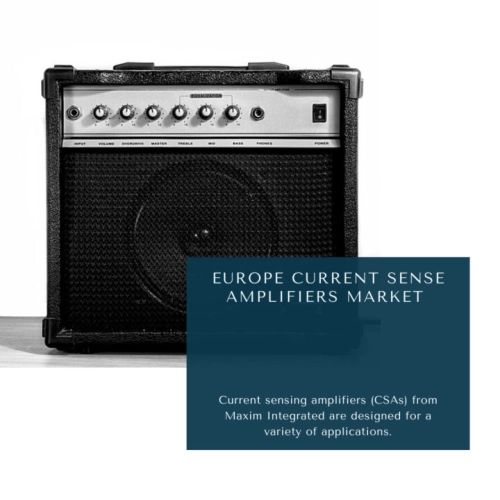
- Get in Touch with Us

Last Updated: Apr 25, 2025 | Study Period: 2022-2027
A current sense amplifier is an integrated circuit differential amplifier that senses the voltage developed across a current shunt and outputs a value proportionate to the measured current. Current sensing is a critical feature in a wide range of products, including industrial automation, telecom infrastructure, portable appliances, and battery-powered gadgets.
The demand for high-power converters and fast, accurate current sensing is steadily increasing.

The Europe Current Sense Amplifiers Market accounted for $XX Billion in 2021 and is anticipated to reach $XX Billion by 2026, registering a CAGR of XX% from 2022 to 2027.
STMicroelectronics has released three precision high-voltage bi-directional current-sense amplifiers that include a Shutdown pin for maximum energy conservation. The TSC2010, TSC2011, and TSC2012 amplifiers also allow designers to use lower value sense-resistors to reduce power dissipation.
The gain range â 20V/V for the TSC2010, 60V/V for the TSC2011, and 100V/V for the TSC2012 â allows for the creation of precise current measurement, overcurrent protection, current monitoring, and current-feedback circuits for a wide range of industrial and automotive applications. Data acquisition, motor control, solenoid control, instrumentation, test and measurement, and process control are some of the applications.
The amplifiers' bidirectional feature aids designers in reducing their bill of materials by allowing a single sensing circuit to measure current flowing in both directions. element14, an Avnet Community, has announced a new hands-on competition with Maxim Integrated in which community members are challenged to experiment with the MAX40080, a high-precision, fast-response, bi-directional digital current-sense amplifier.
Current sensing amplifiers (CSAs) from Maxim Integrated are designed for a variety of applications, including overcurrent protection and power monitoring system optimization without sacrificing measurement precision.
| Sl no | Topic |
| 1 | Market Segmentation |
| 2 | Scope of the report |
| 3 | Abbreviations |
| 4 | Research Methodology |
| 5 | Executive Summary |
| 6 | Introduction |
| 7 | Insights from Industry stakeholders |
| 8 | Cost breakdown of Product by sub-components and average profit margin |
| 9 | Disruptive innovation in the Industry |
| 10 | Technology trends in the Industry |
| 11 | Consumer trends in the industry |
| 12 | Recent Production Milestones |
| 13 | Component Manufacturing in US, EU and China |
| 14 | COVID-19 impact on overall market |
| 15 | COVID-19 impact on Production of components |
| 16 | COVID-19 impact on Point of sale |
| 17 | Market Segmentation, Dynamics and Forecast by Geography, 2022-2027 |
| 18 | Market Segmentation, Dynamics and Forecast by Product Type, 2022-2027 |
| 19 | Market Segmentation, Dynamics and Forecast by Application, 2022-2027 |
| 20 | Market Segmentation, Dynamics and Forecast by End use, 2022-2027 |
| 21 | Product installation rate by OEM, 2022 |
| 22 | Incline/Decline in Average B-2-B selling price in past 5 years |
| 23 | Competition from substitute products |
| 24 | Gross margin and average profitability of suppliers |
| 25 | New product development in past 12 months |
| 26 | M&A in past 12 months |
| 27 | Growth strategy of leading players |
| 28 | Market share of vendors, 2022 |
| 29 | Company Profiles |
| 30 | Unmet needs and opportunity for new suppliers |
| 31 | Conclusion |
| 32 | Appendix |